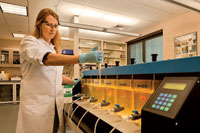Testing for new toxin in water could be costly

The Environmental Protection Agency’s (EPA) new recommendations for monitoring the toxin hexavalent chromium, also known as chromium-6, could prove costlier and more difficult than the agency’s previous requests for monitoring of other unregulated contaminants, a water industry advocate says. And, if the resulting data determines that chromium-6 exists in high enough levels to cause health problems for residents, new regulations could require a substantial upgrade in many water utilities’ facilities.
On Jan. 11, EPA Administrator Lisa Jackson issued the agency’s suggestions for monitoring drinking water for chromium-6 after the Environmental Working Group (EWG) released a study that found traces of the heavy metal in tap water in 31 of 35 U.S. cities. Chromium-6 is not among the 85 contaminants regulated by the EPA for which water utilities must monitor, which include bacteria such as E-coli, and chemicals such as arsenic, lead, benzene, styrene, chlorine, disinfectants and disinfectant byproducts. However, the EPA requires all water utilities that serve more than 10,000 customers, and some smaller utilities that meet certain requirements, to periodically test for a specified list of unregulated contaminants to determine whether their levels are high enough in drinking water to warrant new standards, says Tom Curtis, deputy executive director for government affairs at the American Water Works Association (AWWA).
The EPA specifies which laboratory methods utilities can use to test water samples. In the current Unregulated Contaminant Monitoring Rule, testing is required four times a year for each surface water source and twice a year for each groundwater source. Tests cost about $1,000 for each round of sampling each source. The EPA pays the testing costs for smaller utilities.
But the EPA’s recommendations for chromium-6 testing have proven to be more challenging for most utilities across the country, Curtis says. For example, AWWA is hearing that utilities are having trouble finding a lab that can do the testing. Curtis says many water utilities will have to pay to ship their water samples to laboratories out of state because labs in their area are not equipped to perform the specialized testing suggested by the EPA. For other unregulated contaminants, most utilities manage the costs of monitoring by testing water samples in-house or sending samples to laboratories in-state, Curtis says.
Should the EPA later decide to set a legal limit for chromium-6, Curtis says, utilities around the country could face paying tens of millions of dollars to implement technologies such as reverse osmosis and ion exchange that can remove chromium-6 that may be in water, he says.
The cost of monitoring chromium-6 is one issue under consideration in Norman, Okla., which ranked first on the EWG report for chromium-6 contamination at 12.9 parts per billion. The city has since formed two committees to explore options for monitoring and removing chromium-6, says Ken Komiske, Norman’s director of utilities. “We’re looking at several alternatives, but the unknown here is what [chromium-6] levels we’re supposed to meet,” Komiske says. “If the EPA regulations change, we don’t know what that will be, so we don’t know what to aim for right now.”




















